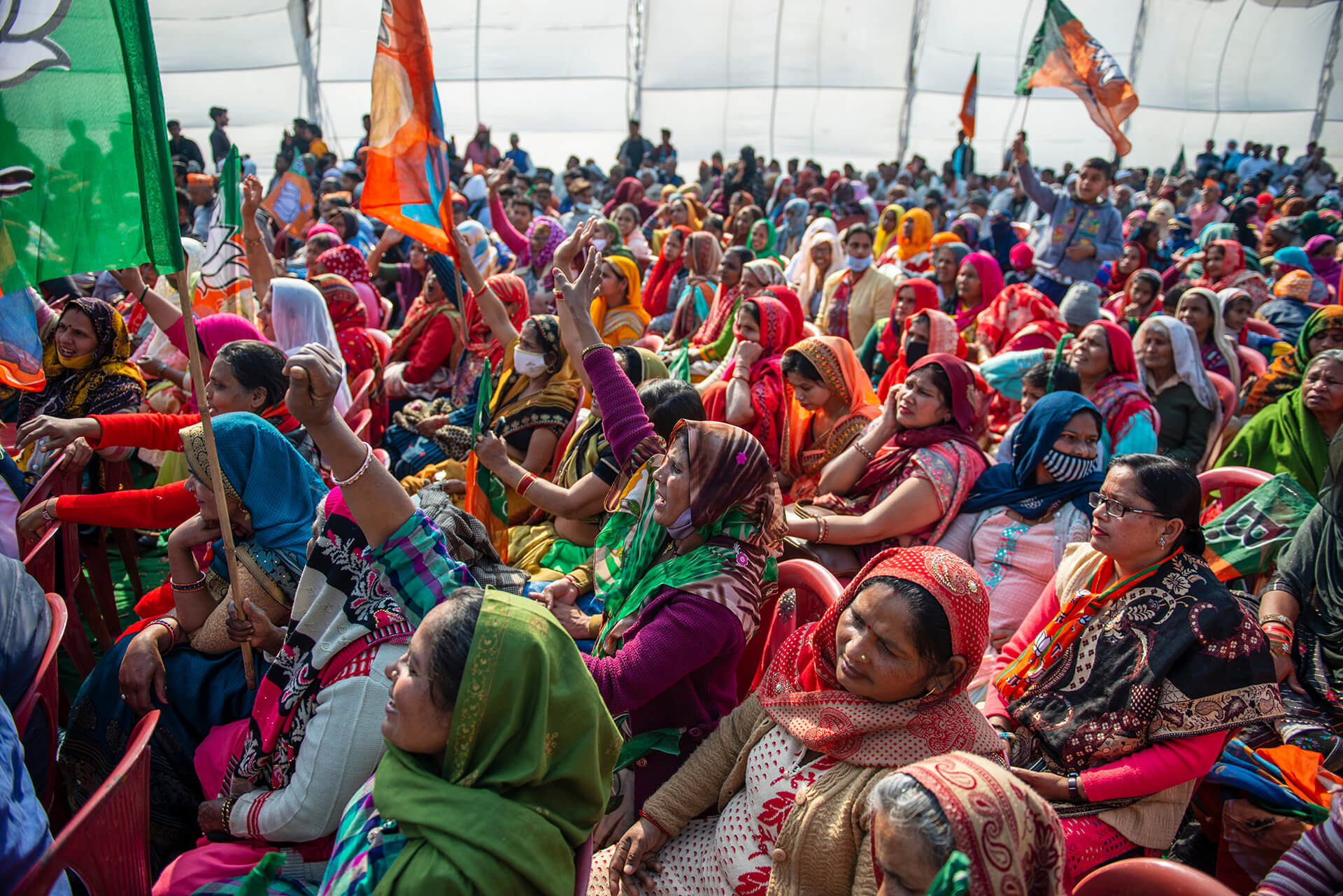In the leadup to the 75th anniversary of Indian independence, a variety of articles appeared in the US press writing the epitaph for its democracy. The future of India’s democracy “looks increasingly bleak,” according to the Associated Press, and we learn in The Washington Post that India’s democracy “dies in prime time.” These articles attributed many of India’s woes to Prime Minister Narendra Modi and his Bharatiya Janata Party (BJP). Yet few of these articles asked why Modi and his party continue to win elections. One answer might be his success in attracting female voters.
Few in the US or the UK realize that Modi’s party has been increasingly successful with women voters. This year key Indian states went to the polls. The BJP did better among women than among men. In India’s most populous state of Uttar Pradesh (UP), 48% of women voted for the BJP in comparison to 44% of the men. Despite the BJP’s UP success, the BBC dryly asked “Are women really thriving in UP as PM Modi claims?” The article concludes with the quote “Women here have very little freedom. They are told who to vote for and they often vote along with the rest of the family.”
Data shows women exercise choice
The BJP is facing a common refrain: India is a misogynistic country that disempowers women, and women vote dutifully for the BJP because they are instructed to do so by their men. If that is true, how do we explain women voting for the BJP in greater numbers than men?
India’s Foreign Minister Schools Western Journalist
According to a survey done by India Today-Axis My India (the group that most accurately predicted the May 2019 national election results), 46% of women voted for the BJP and its allies, 27% for the Congress and its allies, and 27% for other parties. In comparison, 44% of men voted for the BJP and its allies. The male vote lagged the female vote by two percentage points. Notably, this election marked the first time more women than men voted for the National Democratic Alliance, a coalition of the BJP and its allies, in a national election.
So what is going on here? Are women doing as they’re told more often than they’re being told to do it? Some have concluded the data suggest “women voters are perhaps making different political choices from the male members of their families.” If so, then why? The answer seems to lie in the BJP’s prioritization of women’s issues. From toilets and menstrual hygiene to piped water supply and cooking gas, the BJP has made women’s issues central to its agenda.
In 2020, Modi broke a longstanding taboo by addressing the issue of menstrual health in his August 15 Independence Day speech. He declared “Through 6,000 Jan Aushadhi centers, about 50 million women have got sanitary pads at [Rupee] 1 . We have worked for women’s empowerment. Navy and Air Force are taking women in combat roles…women are now leaders.” Note that one rupee is a little over one cent. This means that women can get sanitary napkins at the cheapest rate in the world.
Modi’s claim of putting women in positions of power is no empty boast. In Gujarat, he was succeeded as chief minister by Anandiben Patel, who is now the governor of UP. This year, Modi’s BJP has elected Draupadi Murmu as president. She is the second woman to hold that office. More importantly, she is the first woman who comes from India’s long-oppressed scheduled tribes to become president.
Modi’s outreach to women is part of a longstanding BJP tradition. From the very beginning, the party created Mahila Morcha, its extremely active women’s wing. It had strong female leaders such as Vijaya Raje Scindia and Sushma Swaraj, both of whom died after decades of public service. With Murmu as the head of state, the BJP is sending the signal to women from underprivileged backgrounds that they too can rise to the top.
Well-implemented schemes prove popular with women
Newly independent India’s socialist state proved adept at highfalutin rhetoric but poor at the delivery of public services. Since Modi came to power in 2014, these fundamental services have been prioritized with effective outcomes. Some schemes are noteworthy to understand what is going on.
- In 2014, the state of sanitation in the country was poor. Only around 40% of households had access to a toilet. With the introduction of Swachh Bharat Mission – Grameen (SBM-G), over 100 million household toilets have been constructed in rural India over the last six years.
Toilets have led to improved sanitation and better hygiene for millions, especially women and girls. Household toilets ensure better menstrual hygiene, fewer bladder infections and better reproductive health. Women’s personal safety improves because they are not going out to the fields or the train tracks where they could be harassed or even assaulted by men.
- On May 1, 2016, the Modi government launched Pradhan Mantri Ujjwala Yojana (PMUY) to provide a clean cooking fuel: liquified petroleum gas (LPG). For decades, Indian women were using firewood, cow dung and other biomass to cook. Long term exposure to biomass as cooking fuel is disastrous. The disastrous effects of long-term exposure to biomass as a cooking fuel are well known: it damages lungs for life and shortens lifespans.
With the implementation of PMUY, the national LPG coverage has increased from 61.9% percent as of April 1, 2016, to 99.5% as of January 1, 2021. Academics rightly point out that this transition from biomass to clean cooking has faced challenges. However, it is also clear that the Modi government’s efforts are starting to pay off.
- Since Modi came to power in 2014, his BJP government has focused on the Jal Jeevan Mission. By 2024, the government aims “to provide safe and adequate drinking water through individual household tap connections to all households in rural India.” Access to clear water is a common problem throughout developing countries and causes deaths of millions. To Modi’s credit, he has focused on solving this problem for India.
As recently as 2019, only 17% of Indian households had access to functioning tap water supply in contrast to 52% today. Strikingly, more than a third of India (35%) gained access to clean water in just three years. Hundreds of millions no longer have to trek to community wells or other water bodies away from their homes. Now, they can get water through the tap. Note that fetching water is an arduous job that is almost invariably done by women, who are delighted that the Modi government is delivering on something that matters to them.
- Launched in 2015, the Modi government’s Beti Bachao Beti Padhao (Save Daughter, Educate Daughter) has sought to change attitudes towards birthing and the rights of girls. Over the course of just a few years, the Sex Ratio at Birth (SRB) has improved by 16 points from 918 in 2014-15 to 934 in 2019-20. Some of this might be a feature of economic growth.
The Old Woman and the QR Code
The narrative of a fashionable, barrel-chested Modi may have an element of allure. It may even appeal to some voters. However, this narrative is woefully incomplete. Under Modi, the polls give a sense that the BJP has successfully delivered on issues that matter to women.
Cannily, Modi is cultivating his female voter base. Earlier this year, the prime minister declared: “Women…have blessed us – we have won splendidly in areas where women voters have dominated.” He went on to say, “It is our good fortune that BJP has got so much love, so many blessings from mothers-sisters-daughters.”
Women seem to have blessed the BJP, and a fair review of the data might reveal this fortune is no mere accident, nor the result of “toxic men” telling women how to vote, but because the Modi government has been successful in improving the domestic lives of women. As independent India celebrates its 75th birthday, western journalists and Americans should recognize India is a robust democracy. Honest assessments are fair and to be lauded, and no one should uncritically accept any narrative, but the recent stories in Associated Press, The Washington Post or The New York Times seem facile at best and dismissive at worst. Women from disadvantaged groups in India’s society are rising to better lives, greater hopes, and hundreds of millions have reason to believe a healthier, brighter future awaits them. If that’s not a democratic ideal, I don’t know what is.
[An earlier version of this article referred to the president belonging to the scheduled castes. This error was spotted by many readers and was corrected at 15:00 GMT]
The views expressed in this article are the author’s own and do not necessarily reflect Fair Observer’s editorial policy.
Support Fair Observer
We rely on your support for our independence, diversity and quality.
For more than 10 years, Fair Observer has been free, fair and independent. No billionaire owns us, no advertisers control us. We are a reader-supported nonprofit. Unlike many other publications, we keep our content free for readers regardless of where they live or whether they can afford to pay. We have no paywalls and no ads.
In the post-truth era of fake news, echo chambers and filter bubbles, we publish a plurality of perspectives from around the world. Anyone can publish with us, but everyone goes through a rigorous editorial process. So, you get fact-checked, well-reasoned content instead of noise.
We publish 2,500+ voices from 90+ countries. We also conduct education and training programs
on subjects ranging from digital media and journalism to writing and critical thinking. This
doesn’t come cheap. Servers, editors, trainers and web developers cost
money.
Please consider supporting us on a regular basis as a recurring donor or a
sustaining member.
Will you support FO’s journalism?
We rely on your support for our independence, diversity and quality.







Comment